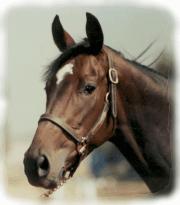A Horse, of Course with Don Blazer |
If you enjoy learning about horses, then you'll love our online courses. Each month you'll find a new column on our web site. We hope you'll enjoy it, and maybe e-mail us with questions or suggestions for other columns. A Horse, Of Course is a monthly column syndicated by Success Is Easy. If you like the column, call your local newspaper, or local horse publication and ask them to subscribe by contacting Success Is Easy. |
The rollback is a great suppling
exercise, helps to slow a horse’s pace and helps correct the often misused indirect
rein of opposition. A rollback is a stopping and turning movement all in one in which the horse turns 180 degrees over a hind pivot foot. The movement helps to supple the horse by asking for a lifting action from the hindquarters, a softening of the body and lateral crossing of the front legs all at the same time. While the movement sounds complicated, it really isn’t. The horse is moving in a straight line and is going to be asked to rollback to the left. The rider gives an introductory cue, and then must provide immediate freedom. The rider begins the exercise by applying an indirect rein of opposition---the rein is moved back toward the rider’s left hip (opposition) while also being pushed against the right side (indirect) of the horse’s neck. The rider’s left leg is pushed against the horse to drive the left hind foot forward, setting the pivot foot. The rider’s weight is shifted slightly toward the horse’s left hip to hold the pivot foot. The rider’s right leg is moved slightly forward and pushes the forehand to the left in concert with the indirect rein being applied to the right side of the horse’s neck. The instant the horse recognizes the cues and begins the rollback, the rider must release the cues and allow the horse the freedom to come around, completing the exercise on his own. With the release of the cues, the rider has told the horse that something new will be coming, listen for the next cue. The rider gives the next cue, which reestablishes the gait at which the horse began the rollback. If the horse was jogging, then the rider asks the horse to continue the jog. The bending involved in the rollback helps to supple the horse. The bending, however, should be minimal rather than drastic. When the horse is asked to make the turn back over the pivot foot, the head must be tipped just a little into the direction of travel. The horse should not bend the neck into a “U” shape. It is at this point in the cueing that the indirect rein of opposition is so often misused. The opposition part of the rein cue should be nothing more than the establishment of a bit barrier to forward move, not a drastic pull backward on the rein. (Often, it is just a lifting of the hand to take the slack from the rein.) And the indirect part of the rein cue should be a pushing action into the neck. The rider must not allow any “pulling of the rein” as that will apply unwanted pressure on the bit, in turn pulling the head in the opposite direction of the wanted movement. Opposition rein cues should never involve a constant pressure backward, but should be the establishment of a barrier to forward movement. Every rein of opposition cue should be minimal in backward movement. Move the rein back enough to set the bit barrier, and then hold the rein in that position (during a half-halt, for example) or release immediately upon the horse’s correct response. I like to use the rollback as a means of teaching the horse to slow and soften his forward movement. (See a demonstration of a rollback at: At the first sign the horse is increasing pace, I ask for a rollback, moving the horse off in the opposite direction. The horse will begin the same gait in the new direction and will be given complete freedom until he starts to increase pace again. With the increase in pace, I ask for another rollback. You will note that your horse starts to hold the slow, soft desired pace after a few (most often less than 10) rollbacks. The rollback is a required movement in many reining patterns and is often done well. When it is not done so well, it is usually rider error caused by a failure to “release” the instant the horse recognizes the request, or the rider stops the horse completely and then does a pivot on the hindquarters—two distinct movements. Rollback to some basics—the stop and pivot--and you’ll find your horse is slower, softer and more supple in his movement. Rollbacks are taught in the HorseCoursesOnline.com Equine Studies course, Training Performance Horses. Visit A Horse, Of Course on the Internet at www.donblazer.com |
